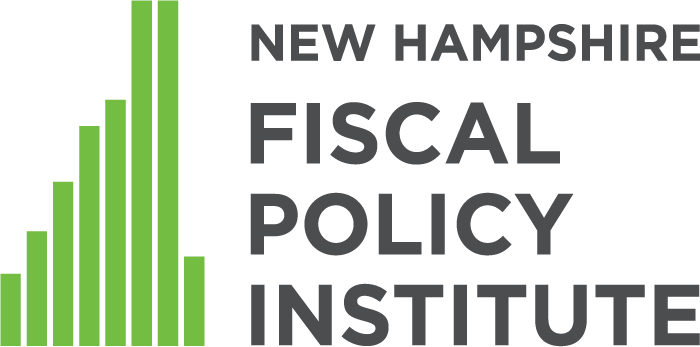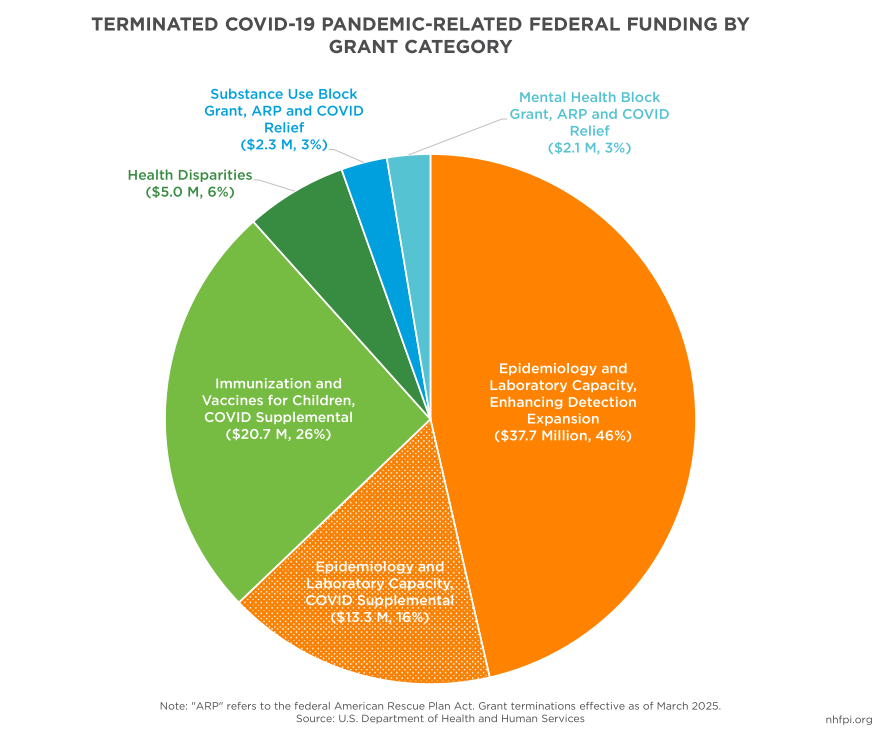On March 24, 2025, the New Hampshire Department of Health and Human Services (NH DHHS) received notice of the sudden end of various pandemic-related federal grants that were not expected to expire until 2026. Over the past week, the U.S. Department of Health and Human Services (U.S. DHHS) released new data providing more insight into this terminated funding.
In short: the total $81.3 million reclaimed by the federal government provided flexible funding support for public health and behavioral health initiatives across the state – funds that were expected to continue into 2026. Let’s dive into where exactly that money goes and what this abrupt move could mean for New Hampshire’s health infrastructure and for Granite Staters.
Background: Where Did the Money Come From?
In response to the COVID-19 pandemic and its impact on public health infrastructure, the federal government enacted several key laws that provided funding to states and local governments to help mitigate and respond to the needs of its residents. Funding terminated in March fell under various pandemic-related grants established through funding associated with larger federal laws, including the Coronavirus Response and Relief Supplemental Appropriations Act (CRRSAA) that passed in December 2020, the American Rescue Plan Act (ARPA) of 2021, and other federal Acts. Terminated grants were awarded by both the U.S. Centers for Disease Control and Prevention (CDC) and the U.S. Substance Abuse and Mental Health Services Administration (SAMHSA) and were commonly referred to as “COVID supplemental grants.”
The NH DHHS was informed that these grants were terminated “for cause,” potentially meaning that the state, as well as all the other states that had their funding terminated simultaneously, may have failed to comply with established terms and conditions of the awards. According to the NH DHHS, state officials were informed that the conclusion of the pandemic provided justification for the sudden termination of these COVID-19-related grants before expiration.
As identified in lawsuit documentation around these funding losses, other states received similar general language in their grant termination letters. While New Hampshire was not among the 23 states and D.C. to join the lawsuit brought against the federal government, state officials have filed an administrative appeal around these terminations, as identified during DHHS testimony to the Senate Finance Committee on April 28, 2025.
The Breakdown: Which Programs Lost the Most?
The $81.3 million in terminated funding was categorized into four key areas, including:
- $51.1 Million – Epidemiology and Laboratory Capacity
- $20.7 M – Immunization and Vaccines
- $5.0 M – Health Disparities
- $4.4 M – Mental Health and Substance Use
Among the terminated funding was $51.1 million reserved for the Epidemiology and Laboratory Capacity for Prevention and Control of Emerging Infectious Diseases (ELC) Program, constituting about two thirds (62.8 percent) of the total funds reclaimed by the federal government in March. These allocations included funding from supplemental grants to assist with emergency response efforts and expanded resources among the ELC Program, including increasing laboratory and testing capacity, as well as expanding epidemiological research and surveillance. Specific funding under the Enhancing Detection (ED) Expansion Grant, designed to build upon other ELC grants, was the largest category of funds reclaimed, equating to around $37.7 million (46.4 percent) of the total. According to federal documentation, New Hampshire received approximately $78.3 million in ED Expansion funding at the start of the pandemic, with around half (51.8 percent), or $40.5 million, expended at the time of termination.
The reclaimed funds also included supplemental grants to help aid in vaccination outreach for adults and children across the state, formally referred to as the Immunization and Vaccines for Children Program. These allocations represented around $20.7 million, or a quarter (25.5 percent), of the total terminated grants. According to the U.S. DHHS, approximately $44.8 million in supplemental immunization funding was awarded to New Hampshire throughout the pandemic, with around half (53.7 percent), or $24.1 million, expended as of March 2025.
Grant funding dedicated to addressing health disparities was also terminated, equating to about $5.0 million (6.2 percent) of the total receded allocations. This grant, formally known as the National Initiative to Address COVID-19 Health Disparities Among Populations at High Risk and Underserved, Including Racial and Ethnic Minority Populations and Rural Communities, provided flexible funding for increased testing, contact tracing, and preventative outreach among at-risk communities. New Hampshire received approximately $24.6 million in Health Disparities Grant funding, passed as part of the larger CRRSAA and awarded by the CDC, with around $19.5 million (79.5 percent) spent at the time of termination.
While SAMHSA allocations for behavioral health represented a smaller portion of the reclaimed funds, four CRRSAA and ARPA-related grants were terminated among both the Community Mental Health Services Block Grant (MHBG; $2.1 million, 2.6 percent of terminated funding) and the Substance Use Prevention, Treatment, and Recovery Services Block Grant (SUBG; $2.3 million, 2.8 percent). When combined, New Hampshire received approximately $20.1 million in pandemic-related funding for mental health and substance use among these grants, with $15.7 million (78.0 percent) expended at the time of termination.
Impacts on Public Services
According to the NH DHHS, the termination of federal funding impacted approximately 30 active contracts with various organizations and entities across the state, with contracts scheduled to conclude at a variety of times ranging from this year until the end of State Fiscal Year 2026, which will occur on June 30, 2026. While many contracted organizations still receive federal and state funding for other services, initiatives funded by the rescinded pandemic-related funding faced immediate termination.
Public Health Labs Lose Key Testing and Staffing Support
The termination of ELC funding had an impact on several contracts for critical public health laboratory functions, including specimen testing and IT data system support, as well as laboratory equipment purchase orders through the Department of Administrative Services. The ELC ED Expansion Grant also supported temporary contracted public health staff, including those performing crucial disease and water laboratory testing.
Community Health Workers Face Job Loss and Patients Face Service Disruptions
The terminated Health Disparities Grant, and portions of the immunization supplemental grants, supported funding for Community Health Workers (CHWs) across the state. Pandemic-related federal grants helped to expand the work of CHWs, who are typically members of the community in which they serve and provide case management-level services. This includes resource outreach, such as connecting clients with food assistance or child care, health education, including the management of chronic diseases, and health system navigation, allowing for direct patient-provider advocacy. According to available data, 39 CHWs were funded through the terminated Health Disparities grant, with CHWs employed by Regional Public Health Networks, Federal Qualified Health Centers, and Community Health Centers.
Behavioral Health Programs Lose Operational Funding
Terminated mental health and substance use grants primarily impact operational funding and support, rather than direct patient services. This support included funding provider training for the State’s Rapid Response System, first responder training on PTSD and trauma-informed care, and assistance for Community Mental Health Centers working to become federally Certified Community Behavioral Health Clinics (CCBHCs), among other behavioral health operational initiatives.
Possible State Budget Reductions Could Compound Challenges
These federal terminations come at a time when the state is already facing revenue shortfalls and fiscal challenges in funding behavioral and public health initiatives in the upcoming State Budget biennium. In the House’s State Budget proposal, funding for the Division for Behavioral Health would decline by approximately $42.9 million (12.3 percent) from the Governor’s proposal, almost entirely due to significant reductions ($37.8 million, 37.5 percent) for Community Mental Health Supports. While funding for the Bureau of Laboratory Services, which provides allocations for the ELC Program, remained relatively unchanged in the Governor’s and House’s proposals, the House proposed a $5.0 million (1.8 percent) decline for the Division of Public Health Services, potentially impacting other public health initiatives across the state.
Next Steps
The Senate continues to consider funding needs in its phase of the State Budget process this month. Reductions in funding could limit the likelihood of finding other federal or State funds to backfill the gap in resources left by the termination of these $81.3 million in federal dollars.


